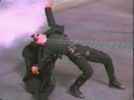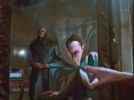Interview
with Dane Davis, Sound Designer, "The Matrix"
Dane
A. Davis was the supervising sound editor and sound designer on the Warner
Bros. post-apocalyptic sci-fi thriller, "The Matrix," written and directed
by Andy and Larry Wachowski.
"The Matrix" begins when a computer hacker Thomas "Neo" Anderson  (Reeves)
is kidnapped into the year 2199 by a band of time-bending cyber rebels led
by martial arts master Morpheus and his followers Trinity and Cypher, in
the hopes that Neo is "The One" who could break the power of a world-dominating
computer and save the future of mankind. (Reeves)
is kidnapped into the year 2199 by a band of time-bending cyber rebels led
by martial arts master Morpheus and his followers Trinity and Cypher, in
the hopes that Neo is "The One" who could break the power of a world-dominating
computer and save the future of mankind.
Dane Davis has been credited as supervising sound editor on over 60 films
during the last 15 years, including "Boogie Nights" for New Line Cinema,
"Mother" for Paramount, "Drugstore Cowboy" for Avenue Pictures, and "Gotti"
for HBO which won him the MPSE Golden Reel Award for Best Sound Editing
in a TV Movie or Pilot in 1996. He also has his own sound post-production
company called Danetracks, Inc. and is currently mixing the independent
production, "Sand," produced and directed by Matt Palmieri.
When did you get involved with
"The Matrix"?
About three years ago, when almost all the same crew, including cinematographer
Bill Pope, picture editor Zach Staenberg and composer Don Davis, made the
first Wachowsky brothers film "Bound," produced by DeLaurentis Entertainment.
Even back then, the Wachowsky brothers actually had a finished script of
"The Matrix" which we read, and while discussing the project we developed
an overall concept for its sound design. They shot the film in nine months
in Sidney, Australia. I went there in July on their last day of shooting,
and worked on the movie until up to a week before its release. I created
the sound effects on an Avid Pro Tools system here at Danetracks, Inc. with
the help of effects editor Julia Evershade and Eric Lindeman who
created many of the gun and helicopter effects. It's actually a DigiDesign
ProTools system (with many plug-ins), although the two companies merged
a few years ago. I also used MetaSynth and SoundHack extensively on this
movie. Then John Reitz, Greg Rudloff and Dave Campbell mixed the effects,
dialog and music tracks on a digital Neve console in the brand new Stage
6 on the Warner Bros. lot. The entire final mix was a magless, tapeless
and drive-based digital mix from original recordings to final printmasters.
How did you help the Wachowsky brothers realize their futuristic vision?
As filmmakers, Andy and Larry are primarily concerned with storytelling
through the characters, and although we knew a film like this offered a
great potential for creative sound work, we never wanted the soundtrack
to call attention to itself beyond the point that is being made in the story.
We wanted the totalitarian computer the rebels battle against to present
only enough detail in the reality they encounter to keep them believing
in it. Both the visual effects and the sound had to support these shifting
levels of credibility, so that when you went to the artificial world of
the future there was a deadly, almost mundane detail to the sound effects
which contrasts with the more contrived and deliberate 'real' world occupied
by the rebels in their underground spy-ship headquarters, the Nebuchadnezzar.
 One
of the unifying concepts of the movie is that everything is motivated by
electricity which results in a lot of sparking and zapping in the future
scenes. For example, the Neb is driven by electromagnetic propellers so
I rented a six-foot Jacob's Ladder and ran 60,000 volts through it to create
the basis for the sound of its engines. One
of the unifying concepts of the movie is that everything is motivated by
electricity which results in a lot of sparking and zapping in the future
scenes. For example, the Neb is driven by electromagnetic propellers so
I rented a six-foot Jacob's Ladder and ran 60,000 volts through it to create
the basis for the sound of its engines.
Time shifting plays a major role in the story. How did you use sound
effects to emphasize this?
We played a lot of games with the speed of the effects. There is a scene
where the police have a tremendous shootout with the rebels in the lobby
of a government building and we employed many different time rates for the
sound effects to key the audience into how fast Neo's brain is working as
the bullets are flying all around. Off-screen, gunshots would pick up in
speed as the visuals went from slow motion to normal, and the bullet 'fly-bys'
would accelerate as they zoomed across the surround speakers. The idea was
to play off the mental aspect of the scene rather than just the physical
violence, so at different times different elements would be emphasized.
Sometimes, you would only hear the marble columns being smashed by automatic
fire and individual chunks of stone flying through the air, while in other
instances you could merely hear the guns themselves. It was a tricky scene
and we felt that it worked out really well.
Which scene was the most challenging for you?
There is a key moment toward the end where Trinity kisses Neo while a battle
is raging around them and the problem was maintaining the romantic intensity
without losing the dramatic tension of the background conflict. We tried
a lot of different ways to keep the sound of the laser beams and metal rending
and banging from stepping on the feeling of the kiss, and in the end, we
came up with the idea of transitioning the full-on attack into a surreal,
deep metallic booming like cannons in the distance while occasionally bringing
some mid-range frequencies back in when Trinity pauses in the kiss. The
scene was built very carefully in terms of where all these resonating metal
hits are positioned throughout the action and it let the intimacy of that
crucial kiss build while the battle continued.
Which sequence do you think would have been most different if someone
else had been the sound designer?
There is a scene where Neo is being encased by what we called a 'mercury
mirror' as the computer tries to take him over, and the
sounds of his own screams being digitized from his perspective was extremely
time-consuming. I don't think anyone else would have done it just the same
way. There are also some evil creatures with mechanical tentacles called
'Squiddies' and we created at least 15 raw digital effects tracks for each
of them, many involving techniques such as in-line pitch shifting and sequenced
samples of screams, screeching bearings and ratchets among other things,
to give the feeling of individual terror as they are burning their way into
the rebels' ship. the
sounds of his own screams being digitized from his perspective was extremely
time-consuming. I don't think anyone else would have done it just the same
way. There are also some evil creatures with mechanical tentacles called
'Squiddies' and we created at least 15 raw digital effects tracks for each
of them, many involving techniques such as in-line pitch shifting and sequenced
samples of screams, screeching bearings and ratchets among other things,
to give the feeling of individual terror as they are burning their way into
the rebels' ship.
Most importantly, there are a lot of fight scenes in "The Matrix" and I
made a point of creating composite body-hit and whoosh sounds that had never
been heard before, using meat hits and animal vocal sounds as sources. They
also evolve from one combat to the next to become increasingly more animalistic
and powerful. I don't want to reveal the source for them in any greater
detail, but I think it resulted in a sound effects experience that audiences
really believed.
EditorsNet Apr 1999
|